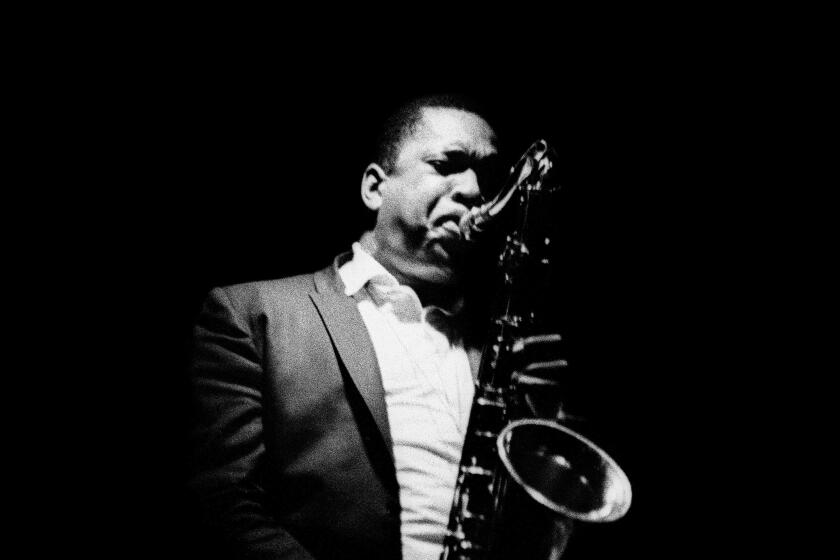‘One Nine Special’ Makes Whistle-Stop at Union Station : Art: The exhibition of site-specific artworks by three British artists and five from Los Angeles runs through Oct. 2.
- Share via
Union Station is many things to many people. It’s a symbol of Los Angeles’ continuing attraction for immigrants and tourists. It’s a gem of Spanish-Colonial-style architecture that has been designated the City of Los Angeles’ Historic Cultural Monument No. 101. It’s also a downtown hub of transportation. But is it art?
Consider the following:
A “bracelet” of perpetually blinking traffic lights, made by Los Angeles artist Sheila Klein, who creates jewelry for buildings, now sits on a tile walkway in the station’s south patio.
Reflections of a stained-glass heart installed in the window above the grand entrance by British artist Yuca Ishizuka bathe late afternoon visitors in brilliant light.
Windows of a central kiosk contain Los Angeles artist Jennifer Steinkamp’s computer-generated images of pink and blue smoke.
Official-looking plaques strategically placed around the station tell travelers’ stories, culled from 70 interviews conducted at Union Station by Los Angeles artist Elizabeth Bryant.
A free “newspaper” distributed at the station is a collection of cartoons assembled by Theresa Pendlebury, also of Los Angeles.
Taking all this in, a man sitting in a vintage leather-upholstered chair in the stately waiting room stares at a curtain of 20,000 Amtrak tickets made by British artist Cornelia Parker and asks, “What’s going on here?”
Art, that’s what. The occasion is “The One Nine Special,” an exhibition (through Oct. 2) of works by three British artists and five from Los Angeles. A production of Wise Taylor Partners, a London-based nonprofit “arts practice,” the show is the second segment of a two-part exhibition, “Summer Lightning,” which began earlier this summer at Dreadnought Seamen’s Hospital in Greenwich, near London.
In that event, 11 artists designed works for a building that was vacated in 1986 after 116 years of serving as a merchant seamen’s hospital and an additional century as a home for naval pensioners. Artworks in the critically acclaimed show dealt with themes such as nursing and seamen’s diseases.
*
Unlike the abandoned hospital, Union Station is alive and looking marvelous, but the artists involved in the local show also have created works that address the 1939 building’s structure and purpose.
“I’m completely obsessed by art in architecture,” curator Georgie Wise said in an interview at the station. “Architecture surrounds people and influences them tremendously. We want to use it to provide a cultural dialogue and access to art,” she said of the partnership she and architect Ian Taylor established three years ago to place the arts in architectural settings.
In choosing the American location for “Summer Lightning,” Wise listened to several friends who advised her to check out San Francisco. “I went there and thought, ‘This is nice but we have a lot of this in Europe,’ ” she said. “Then I came to Los Angeles, and I thought, ‘My God, this is liberation. This is my history.’ I didn’t live in the 19th Century. Los Angeles is 20th-Century history.”
Union Station proved to be the most workable of several Los Angeles venues she considered. Having first secured support from the British Council, a governmental arts agency, Wise enlisted sponsorship from the UK/LA Foundation, the California Arts Council, the Community Redevelopment Agency, the Foundation for Art Resources, Los Angeles’ Cultural Affairs Department and Catellus Development Corp., which manages Union Station. The two-part show has a budget of about $50,000--about $17,000 of it allocated to the Los Angeles portion.
“I love the attitude here,” Wise said. “People listen to you and say, ‘OK, as long as you can do it. But you’d better do a good job.’ That’s a wonderful mentality. If you mess up, you won’t get another chance, but all I need is one chance.” A resume that includes arranging exhibitions and performances in Europe and China, plus a couple of handsome catalogues helped to inspire confidence in Wise Taylor’s professional expertise, she noted.
While scouting sites, Wise visited artists’ studios and put together a roster of 14 British and American women, eight of whom are in the Los Angeles show. Giving preference to women is a way of redressing history’s exclusion and recognizing little known talent, she said, noting that about 70% of the artists featured in Wise Taylor exhibitions are female.
“To survive as an artist in Los Angeles, you have to be damn good. But to survive as a woman artist in Los Angeles, you have to be out of sight,” Wise said. What pleases her most is the artists’ research and planning that makes their work relevant to the historic site.
*
Some works are so subtle or unexpected that they may go largely unnoticed. Bryant’s plaques, for example, look like they belong in the building, while similar recorded messages are interspersed with official announcements over the public address system.
That’s all right with Wise, who loves the idea of integrating art into architecture so thoroughly that it can be assimilated like piped-in music before being discovered.
Visitors may not get the drift of British artist Dierdre McCloskey’s installation of 84 cables, symbolizing the languages spoken by Los Angeles immigrants, which are strung between two ornate speakers high on one wall. But McCloskey’s four flags in the south patio clearly spell a four-letter message: move. The word obviously relates to travel, while the material--rolls of unused film that the artist found in a local warehouse--suggests both the film industry and tourist photography.
For those who like to ponder the many meanings of art, travel and life, Los Angeles artist Yolande McKay provides plenty of inspiration for head trips. She has constructed a sign posting fictional “departures” and “arrivals.” Want to go to Camelot, Tara, Desolation Road or Oz? Meeting a train from Swans Way, Bitter End, Purgatory or Nirvana? Here’s the information you need.
McKay said she chose places from a variety of sources to reach a broad audience. She invented track numbers for the trains and selected arrival and departure times in the early morning, late afternoon and evening to correspond to dream cycles. A painting resembling a road map on the front of the free-standing sign represents the human brain’s lines of communication. On the back of the sign are illustrations and text from a study of the brain patterns and behavior of delinquent youth.
With artworks in place, “The One Nine Special” has taken off for a monthlong run at Union Station. But if Wise has her way, the exhibition is only the beginning of a continuing relationship between her partnership and Los Angeles. “We aim to develop a dialogue over the next four or five years,” she said.
More to Read
The biggest entertainment stories
Get our big stories about Hollywood, film, television, music, arts, culture and more right in your inbox as soon as they publish.
You may occasionally receive promotional content from the Los Angeles Times.










